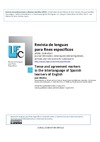Identificador persistente para citar o vincular este elemento:
https://accedacris.ulpgc.es/jspui/handle/10553/72299
| Campo DC | Valor | idioma |
|---|---|---|
| dc.contributor.author | Medina, Jose | en_US |
| dc.date.accessioned | 2020-05-12T16:55:41Z | - |
| dc.date.available | 2020-05-12T16:55:41Z | - |
| dc.date.issued | 2015 | en_US |
| dc.identifier.issn | 1133-1127 | en_US |
| dc.identifier.other | WoS | - |
| dc.identifier.uri | https://accedacris.ulpgc.es/handle/10553/72299 | - |
| dc.description.abstract | This paper presents an analysis of the learning process of the features of tense and agreement in the interlanguage system of L1 Spanish speakers learning L2 English. This study uses a statistically significant sample of the student population in year 6 of primary education (11-12 years old), year 4 of secondary education (15-16 years old) and upper sixth form (17-18 years old), in the Autonomous Region of the Canary Islands. The research instrument was their written production. The analysis conducted includes the bound morphemes -ed and -s and the free morpheme be (with both copular and auxiliary function). The results show a predominant omission for the agreement morpheme -s in the three groups in which the corpus has been divided. On the other hand, the bound morpheme -ed and the free morpheme be present the highest percentage of correct use. These results confirm the capacity of the subjects to learn the verb features of tense and agreement, thus supporting the arguments of the Missing Surface Inflection Hypothesis (Prevost and White, 2000). As the results for the bound morphemes are not in agreement, the influence of other factors on the good results of the bound morpheme -ed, such as the verb aspect or the absence of phonological realizations, is suggested. | en_US |
| dc.description.abstract | Este artículo presenta un análisis del proceso de aprendizaje de los rasgos de tiempo y concordancia verbales en el sistema de interlengua de hablantes de español (L1) y aprendices de inglés (L2). En la investigación llevada a cabo se ha utilizado una muestra estadísticamente significativa de la población estudiantil perteneciente al sexto curso de educación primaria (11-12 años de edad), cuarto curso de educación secundaria (15-16 años de edad) y segundo de bachillerato (17-18 años de edad) de la Comunidad Autónoma de las Islas Canarias. El instrumento utilizado para la investigación fue su producción escrita. Se analizaron los morfemas ligados –ed y –s y el morfema libre be (tanto con función copulativa como auxiliar). Los resultados muestran una predominancia de la omisión para el morfema de concordancia verbal –s en los tres grupos que conforman el corpus. Por otro lado, el morfema ligado –ed y el morfema be presentan el mayor porcentaje de uso correcto. Estosresultados confirman la capacidad de los sujetos para aprender los rasgos de tiempo y concordancia verbales, apoyando de esta forma los argumentos de la Hipótesis de la Inflexión Superficial Ausente (HISA) (Prévost y White, 2000). Puesto que los resultados de los morfemas ligados no concuerdan, se sugiere la influencia de otros factores en los buenos resultados obtenidos con el morfema ligado –ed, tales como el aspecto verbal o la ausencia de realizaciones fonológicas. | en_US |
| dc.language | eng | en_US |
| dc.relation.ispartof | LFE. Revista de Lenguas para Fines Específicos | en_US |
| dc.source | Lfe-Revista De Lenguas Para Fines Especificos [ISSN 1133-1127], v. 21 (1), p. 109-131 | en_US |
| dc.subject | 5701 Lingüística aplicada | en_US |
| dc.subject.other | L2 English | en_US |
| dc.subject.other | Written Production | en_US |
| dc.subject.other | Tense | en_US |
| dc.subject.other | Agreement | en_US |
| dc.subject.other | Inglés L2 | en_US |
| dc.subject.other | Producción escrita | en_US |
| dc.subject.other | Tiempo verbal | en_US |
| dc.subject.other | Concordancia | en_US |
| dc.title | Tense and agreement markers in the interlanguage of Spanish learners of English | en_US |
| dc.type | info:eu-repo/semantics/Article | en_US |
| dc.type | Article | en_US |
| dc.identifier.doi | 10.20420/rlfe.2015.0006 | en_US |
| dc.identifier.isi | 000219406500006 | - |
| dc.identifier.eissn | 2340-8561 | - |
| dc.description.lastpage | 131 | en_US |
| dc.identifier.issue | 1 | - |
| dc.description.firstpage | 109 | en_US |
| dc.relation.volume | 21 | en_US |
| dc.investigacion | Artes y Humanidades | en_US |
| dc.type2 | Artículo | en_US |
| dc.contributor.daisngid | 28214773 | - |
| dc.description.numberofpages | 23 | en_US |
| dc.utils.revision | Sí | en_US |
| dc.contributor.wosstandard | WOS:Medina, J | - |
| dc.date.coverdate | 2015 | en_US |
| dc.identifier.ulpgc | Sí | es |
| dc.description.esci | ESCI | |
| dc.description.dialnetimpact | 0,0 | |
| dc.description.dialnetq | Q2 | |
| dc.description.erihplus | ERIH PLUS | |
| item.fulltext | Con texto completo | - |
| item.grantfulltext | open | - |
| Colección: | Artículos | |
Los elementos en ULPGC accedaCRIS están protegidos por derechos de autor con todos los derechos reservados, a menos que se indique lo contrario.
